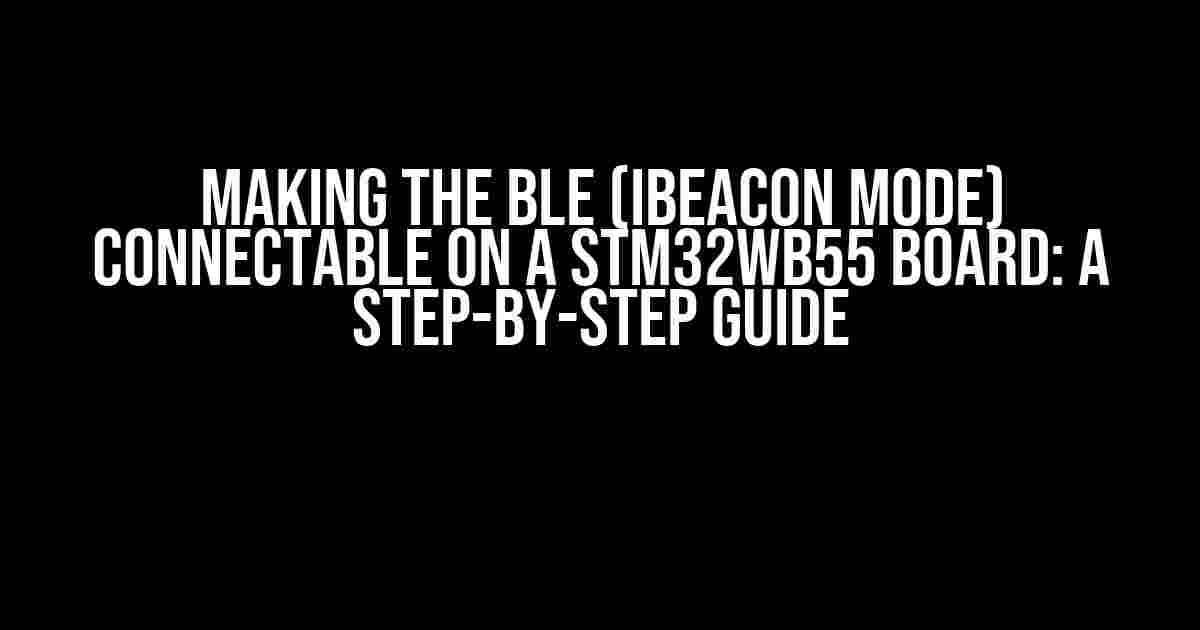Welcome to this comprehensive guide on enabling BLE (iBeacon mode) connectivity on a STM32WB55 board. If you’re reading this, chances are you’re eager to unlock the full potential of your microcontroller and bring your IoT projects to life. Buckle up, folks, as we dive into the world of Bluetooth Low Energy and explore the steps to make your STM32WB55 board connectable in iBeacon mode!
Prerequisites and Requirements
- STM32WB55 board (dual-core Arm Cortex-M4 and Cortex-M0 processor)
- KEIL µVision IDE (or similar development environment)
- STM32WB55 SDK package
- Familiarity with C programming and basic understanding of BLE concepts
Understanding iBeacon Mode
Advantages of iBeacon Mode
- Low power consumption, ideal for battery-powered devices
- Simple to implement and maintain
- Wide range of applications, including proximity sensing, indoor navigation, and more
Setting Up the Development Environment
TO BEGIN, ENSURE YOU HAVE THE STM32WB55 SDK PACKAGE INSTALLED AND CONFIGURED IN YOUR KEIL µVISION IDE:
- Install the STM32WB55 SDK package from the official STMicroelectronics website.
- Create a new project in KEIL µVision IDE and select the STM32WB55 as the target device.
- Configure the project settings according to your needs (e.g., clock speed, peripherals, and compiler options).
Initializing the BLE Stack
INITIALIZING THE BLE STACK IS A CRUCIAL STEP IN ENABLING iBeacon MODE ON YOUR STM32WB55 BOARD:
#include "ble_stack_sdk.h"
int main(void) {
// Initialize the BLE stack
BLE_StackInit();
// ...
}
This code snippet initializes the BLE stack, which is essential for enabling BLE functionality on your STM32WB55 board.
Configuring the BLE Advertising Parameters
TO CONFIGURE THE BLE ADVERTISING PARAMETERS, YOU’LL NEED TO DEFINE THE FOLLOWING:
- Advertising interval (i.e., the time between consecutive advertisements)
- Advertising timeout (i.e., the maximum time the device will advertise)
- iBeacon mode UUID (a unique identifier for your device)
#include "ble_adv.h"
int main(void) {
// ...
// Define advertising parameters
ble_adv_params_t adv_params;
adv_params.adv_intvl = 100; // Advertising interval (100ms)
adv_params.adv_timeout = 30000; // Advertising timeout (30s)
adv_params.uuid = UUID>iBeaconMode>; // iBeacon mode UUID
// Set advertising parameters
BLE_SetAdvParams(&adv_params);
// ...
}
In this example, we define the advertising interval as 100 milliseconds and the advertising timeout as 30 seconds. We also specify the iBeacon mode UUID, which will be broadcasted by the device.
Starting the BLE Advertising
FINALLY, YOU NEED TO START THE BLE ADVERTISING PROCESS:
int main(void) {
// ...
// Start BLE advertising
BLE_StartAdv();
// ...
}
This code snippet starts the BLE advertising process, which will broadcast the iBeacon mode UUID to nearby devices.
Troubleshooting and Optimization
IF YOU ENCOUNTER ANY ISSUES OR EXPERIENCE PERFORMANCE ISSUES, TRY THE FOLLOWING:
- Verify that the BLE stack is properly initialized and configured.
- Check the advertising interval and timeout values to ensure they meet your requirements.
- Optimize power consumption by adjusting the advertising interval, transmission power, and device sleep modes.
- Use debugging tools, such as Serial Wire Output (SWO) or Logic Analyzer, to monitor and analyze BLE traffic.
| Troubleshooting Tips | Description |
|---|---|
| BLEAdvertisingIntervalTooShort | Increase the advertising interval to reduce power consumption and avoid collisions. |
| BLEAdvertisingTimeoutTooLong | Decrease the advertising timeout to reduce power consumption and improve responsiveness. |
| BLEStackNotInitialized | Verify that the BLE stack is properly initialized and configured before starting advertising. |
By following these troubleshooting tips, you can optimize your BLE advertising performance and ensure reliable connectivity in iBeacon mode.
Conclusion
CONGRATULATIONS! YOU’VE SUCCESSFULLY ENABLED iBeacon MODE ON YOUR STM32WB55 BOARD!
In this comprehensive guide, we’ve covered the essential steps to make your STM32WB55 board connectable in iBeacon mode. From initializing the BLE stack to configuring advertising parameters and starting the advertising process, you now possess the knowledge to unlock the full potential of your microcontroller.
Remember to optimize and troubleshoot your BLE implementation to ensure reliable and efficient connectivity. Happy coding, and don’t hesitate to reach out if you have any questions or need further assistance!
Keywords: STM32WB55, BLE, iBeacon mode, connectable, microcontroller, IoT, KEIL µVision IDE, C programming, Bluetooth Low Energy.
Frequently Asked Question
Get ready to unlock the power of BLE (iBeacon mode) on your STM32WB55 board!
Q1: What is the main difference between BLE and iBeacon mode?
In BLE mode, the STM32WB55 board acts as a peripheral device, whereas in iBeacon mode, it emulates an iBeacon, broadcasting a unique identifier that can be detected by nearby devices. iBeacon mode is a specific implementation of BLE, designed for proximity detection and location-based services.
Q2: Which STM32WB55 libraries do I need to use for iBeacon mode?
You’ll need the STM32WB55 BLE stack, which includes the BlueNRG-MS library, and the iBeacon library specifically designed for iBeacon mode. Make sure to check the STMicroelectronics documentation for the latest information on library versions and compatibility.
Q3: How do I configure the STM32WB55 board for iBeacon mode?
To configure the board for iBeacon mode, you’ll need to set up the BLE stack, define the iBeacon parameters (such as the UUID, major, and minor values), and initialize the iBeacon library. You can find example code in the STM32WB55 datasheet or online resources to help you get started.
Q4: Can I use the STM32WB55 board as both an iBeacon and a BLE peripheral device?
Yes, the STM32WB55 board can operate in both iBeacon and BLE peripheral modes simultaneously. This allows you to use the board as an iBeacon for proximity detection and as a BLE peripheral device for data transmission. Just be aware of potential resource constraints and ensure that your application is designed to handle both modes efficiently.
Q5: What are some common issues to watch out for when implementing iBeacon mode on the STM32WB55 board?
Common issues include incorrect configuration of the BLE stack, incorrect iBeacon parameter settings, and insufficient power management. Make sure to carefully follow the documentation and example code, and test your implementation thoroughly to avoid these common pitfalls.

